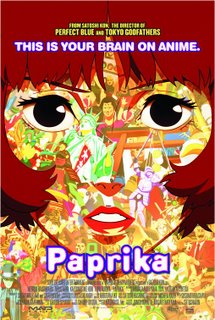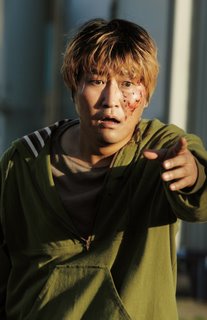 Sleepy, I'm very sleepy. Is it the films or the weather?
Sleepy, I'm very sleepy. Is it the films or the weather?PAPRIKA
Director: Satoshi Kon, Country: Japan, Release: 2006, Runtime: 89 min.
Ghost in the Shell meets Nightmare on Elm Street
A cop is getting therapy to help him with a case. Paprika is using the DC mini, a new cerebral device, to tap into his dreams. Then there is the beautiful doctor, Atsuko, running the lab developing the device created by the sumo-sized Tokito. But things go horribly wrong when someone steals the device and taps into many of the character's dreams. Nightmarish results follow and the girls, Paprika and Atsuko, do battle to save the world from a parade of scary dolls, dancing refrigerators, and a huge melting black hole gobbling up the city. The images are stunning and hallucinatory. There are tons of influences on Satoshi Kon's work - imagery from American movies ranging from film noir to Hitchcock to Tarzan adventures. Luckily the camera moves are also used in the animation so the audience never sees a flat, one-dimensional. There is also a great deal of humor, perhaps criticism, around Japan's obsession with kitschy cute - dolls, pop music, and Sailor Moon. Unfortunately the female characters come across like girls, despite the Dr. title and heroine acts, reverting to objects of sexual desire. There are many animated phallic references; in one scene a child turns into a woman by sucking in all that is bad in the male air. Perhaps it is like the madonna/whore complex where Kon tries to combine the qualities of women as savior or sex kitten. The film drags at times over repeated themes. After the tenth cut to the confetti parade or appliances and toys, thoughts drifted to other things, like grocery lists and home chores. Overall, however, it was a lovely ride with some fun and entertaining elements. I won't hold my breath, however, for a hunky male, female fantasy version of Paprika.
SYNDROMES AND CENTURY

Director: Apichatpong Weerasethakul: Thailand, Release: 2006, Runtime: 95 min.
The Kingdom after a lobotomy
A rural doctor is managing patients and her male suitors in her daily life. She asks questions like "Do you like triangles, squares, or circles?" and" What does DDT stand for?" when evaluating her clients. One suitor is a soldier, another an orchid grower. Scenes shift to a parallel world in the city where a young male doctor treats patients in a large hospital full of halls and industrial objects. He asks the same questions the female doctor asked of her patients. Another symmetry appears when the same monks come to the city for treatment and give a gift of medicinal root to the male doctor, but to cure something else, more male? A woman gets a bottle of hooch out of a prosthetic leg to drink before her TV interview. A boy being treated for carbon monoxide plays with a tennis racket in the hospital halls. A strange vented tube starts sucking in fog from an empty room, camera holding on it's black hole intake for over a minute. All these strange scenes typically have droning, white-noise soundtracks with a few exceptions - a singer and guitar player performing, people doing aerobics in the park. All the elements sound for something invigoratingly bizarre and interesting but the lengthy shots and numbing pace and matching sound tests the audience's patience and many people gave up, walking out. Unlike Lynch's strange scenes, Weerasethakul's work is so disjointed and impossible to link with other pieces in the film, it comes across as gimmicky and overly artsy in a cerebral way. The score and sounds are, however, very interesting choices. Overall, the film is boring and catatonic. I recommend avoiding this dud.
 THE HOST
THE HOST Director: Bong Joon-ho, Country: South Korea, Release: 2006, Runtime: 119 min.
Alien meets Godzilla
An American lab director orders a Korean subordinate to dump formaldehyde into the drain, leading directly to the Han River.* The subordinate complies. Two fisherman notice a strange little fish with a weird mutation - but it gets away. A family run kiosk business serves toasted squid to families sunning themselves on the shores on the Han River. A strange dark object is scene dropping from the bridge into the water. They throw things at it, as if feeding Koi, but it disappears again. A quick camera pan and WHAM! the dang-ugly creature is running down the shoreline smashing things up and gobbling people here and thar. The family is fragmented and the young daughter gets snatched up by the monster. All think she's dead. The U.S. military gets involved, preparing for a virus that they believe the host creature is carrying. The family gets a cell call from the girl and they escape quarantine to look for her. The crazy story is lightened with campy humor and darkened with some harsh criticism of U.S. intrusion (using Agent Yellow to decontaminate the area). The monster is shot in both creepy shadows, close-ups, and in full frame, swinging and running as if some mutant tadpole with T-Rex strength. The very disturbing mouth looks like some strange morphing of the plant in Little Shop of Horrors and something a gynecologist might see. The film has been a huge hit in Korean and parts of Asia. It makes for a good midnighter but lacks consistent quality to be either a cult classic or ageless monster flick. Still, if you like a good monster scare, The Host delivers pure escapism, joy, and jumps.
* reportedly based on a true incident
No comments:
Post a Comment